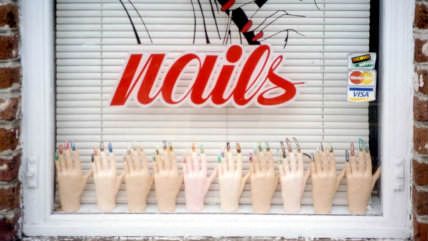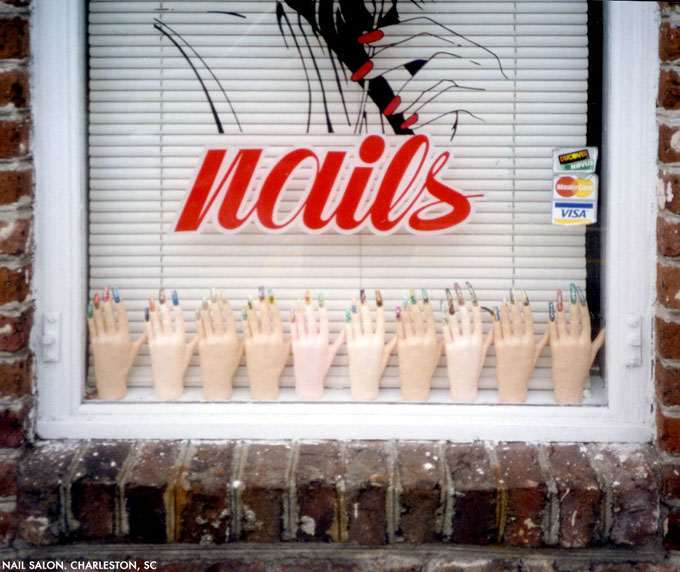What The New York Times Gets Wrong About Cheap Nail Salons
Even if Asian nail salons are as exploitative and toxic as the Times says, the answer isn't more government oversight.


In the 1970s, American actress Tippi Hedren was visiting a Vietnamese refugee camp in California when women there began admiring her nails. Hedren brought in her manicurist to train refugees on giving manicures. "We were trying to find vocations for them," Hedren told the BBC recently. "I brought in seamstresses and typists—any way for them to learn something." Apocryphal or not, Hedren is now credited as the reason "why so many nail technicians are Vietnamese."
"Forty years after the fall of Saigon, 51% of nail technicians in the United States—and approximately 80% in California—are of Vietnamese descent," the BBC reports. Tam Nguyen, president of Advance Beauty College in Laguna Hills, California, said nearly every Vietnamese-American nail technician he knows still sends some money home to support relatives.
These stories present one view of the nail-salon industry in the America: an avenue of opportunity for immigrant workers with low skills and little English. As Asian nail salons have proliferated—often offering manicures, pedicures, and acrylics at a fraction of the cost of high-end salons—immigrant women have trained and employed one another, providing new arrivals with a means of making a living, a way help out families back home, and a community. They have also helped drastically grow the manicure market, making what used to be only a luxury for the rich an affordable and accessible habit for middle-income Americans.
"In the story of nail salon competition, we can see [how] … immigrants expand markets, rather than just taking existing jobs," wrote Virginia Postrel in Reason in 1997.
Twenty years ago, manicurists mostly worked in obscure corners of hair salons or catered to the wealthy. Cher got her nails done; the rest of us did not. Today, free-standing nail salons dot the commercial blocks and strip malls of cities from Southern California to South Carolina.
[…] That's the industry hidden in plain sight. There's also the business you don't see as you walk down the street: the manufacturers and distributors that supply the salons. Nailpro, another trade magazine, lists nearly 400 manufacturers in its 1997 Gold Book directory. These companies make everything from polishes, nippers, and acrylic nail-sculpting compounds to manicure tables, polish racks, and toeless pedicure socks.
But The New York Times this week presents a very different narrative of the nail industry. In a multi-part series by reporter Sarah Maslin Nir, the Times suggests that the real "price of nice nails" is an underclass of immigrant women subject to high rates of exploitation, abuse, fertility issues, and other health problems. New York City manicurists work "10- to 12-hour shifts, hunched over fingers and toes," writes Nir in part one.
Asian-language newspapers are rife with classified ads listing manicurist jobs paying so little the daily wage can at first glance appear to be a typo. Ads in Chinese in both Sing Tao Daily and World Journal for NYC Nail Spa, a second-story salon on the Upper West Side of Manhattan, advertised a starting wage of $10 a day. The rate was confirmed by several workers.
In part two, Nir explores the health problems that seem to plague nail-salon employees: asthma, skin rashes, persistent coughs, a history of failed pregnancies. "Chemicals that make nail and beauty products useful—the ingredients that make them chip-resistant and pliable, quick to dry and brightly colored, for example," are the culprits, Nir notes. Of course, research on these chemicals and any potential hazards is scarce, and the FDA has deemed several of them safe. But Nir seems certain that a lack of FDA oversight combined with indifferent manufacturers are to blame.
"Many owners said they were helping new immigrants by giving them jobs," but Nir is skeptical of this claim based on their low wages. In the mutual-aid services and shared living spaces that spring up around the communities of immigrant salon workers, Nir sees only the tragic consequences of poverty, not the resourcefulness, resiliency, and capability of those forced by U.S. immigration policy into an underground economy.
In the apprenticeship system for that's sprung up in nail salons, she sees only exploitation—the women pay $100 to $200 in training fees and then work for tips for a probationary period before getting a regular wage. But in the formal economy, cosmetologists of all sorts must pay to attend schools and certification programs, pay the government for a licence, and take internships or training programs before salons let them do hair/nails/makeup on their own. Is the apprenticeship system really so different? At least salon workers can still make tips while they train.
In fact—though Nir doesn't mention this until at least half-way through the first article—nail salon workers are, like waiters, considered "tipped workers" under New York State and federal law, which means they're permitted to be paid less than the state's $8.75 hourly minimum. Of course, tipped workers often take home much more than the minimum wage (and often do so off the books in cash heavy businesses), which is why all kinds people continue to seek tipped jobs. In some instances, when the tip-only system has effectively amounted to no wages, salon workers have filed class action lawsuits against salon owners and won. One of the major impediments to doing so, however—or to seeking employment outside these salons—is workers' immigration status. They have trouble participating in the formal economy or legal system because they are in America illegally.
Nir fails to indict U.S. immigration policies for their poor conditions. Instead, she would actually see more government agents visiting the nail salons. "Only a small number of the workers interviewed by The Times said they had ever seen an investigator, from any government agency, at their salon," the article notes with dismay.
Getting more government involved when it's not at the behest of these workers, however, is only going to lead to more hardship for those most marginalized. When state investigators find a bunch of undocumented immigrants working as unlicensed manicurists—yes, being a manicurist in New York technically requires a state permission slip—for under the minimum wage, do you think they're going to stop with forcing employers to institute a pay hike? Do you think salon owners under more investigative scrutiny from government agents are going to be more attune to requests from their underground employees?
I don't want to diminish the concerns of workers in these communities. But this top-down, outsider, progressive, law-and-order view concerns me. Would workers be better off with no jobs or means to support themselves? Living back in their home countries? Maybe in some cases, yes, but we don't know because we are not them. And I tend to believe that immigrant salon workers, being as intelligent and rational as the rest of us, are capable of weighing their own interests and situations and acting accordingly.
Of course, rationality only goes so far as the realities you're aware of. Part two of the Times series focuses on the "poison" nail salon workers are unwittingly exposed to regularly. A woman may consent to long hours but not to constant exposure to chemicals that will cause birth defects, one might say.
Yet for all of Nir's hand-wringing about how the FDA only has the power to ban harmful chemicals (not approve all chemicals going into all products before they go on the market), she fails to make much of a case for how increased FDA oversight would help here. Two of the three nail-polish chemicals health advocates suspect of being most harmful to salon workers have already been declared non-toxic by the FDA. Either they really are non-toxic, or we need outside research, not more of the same. And the nail-salon ingredients that may cause harm to developing fetuses aren't a concern for non-pregnant workers, meaning the issue isn't ousting them entirely but keeping pregnant women away.
Increased FDA oversight can't educate nail workers about the importance of leaving the job when they're pregnant, or help make doing so financially feasible; it can't instill simple best practices, like wearing gloves, that could mitigate skin problems; it can't encourage salon owners to install work on better ventilation systems. These sorts of education and outreach efforts are best undertaken by public health nonprofits and people in these communities. And they would have a much more immediate effect than the years or decades it could take to get accomplish similar feats via federal regulation.
The market can also play a part. We don't know for sure that many nail salon ingredients pose health risks, but if consumers are concerned, they can vote with their dollars. And if consumers aren't concerned enough, it's up to advocates to make the case for why they should be.
As a way to raise consumer awareness, I think Nir's piece works well. But she makes the all-to-common and immediate leap to calling for stricter governmental scrutiny. It's a solution as seemingly simple as it is lazy: just send the government in to help! But when we're talking about communities of people whose very existence here has been deemed illegal, the government doesn't help, it fines and arrests and deports. The best way to actually help people in these communities is to help them help themselves.


Show Comments (142)